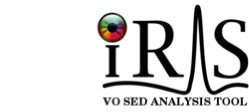Which SED data types are supported by Iris?
The Spectral Energy Distribution (SED) of a source refers to the measured flux, flux density, or luminosity of the source per unit wavelength, frequency, or energy. An aggregate SED can be built by combining photometric points and/or spectroscopic segments from various observatories across a wide spectral range; this is one of the functions of the Iris SED analysis tool. The distinction between a photometric point and a spectroscopic segment is explained below:
A photometric point is defined by three numbers (s, f(s), t), namely a spectral coordinate s (either a wavelength, frequency, or energy), a flux f(s) (or flux density, or luminosity) measured at that spectral coordinate, and the time t of the observation.
A spectroscopic segment consists of a relatively tightly spaced collection of adjacent spectral coordinates and corresponding fluxes (or luminosities): (si, f(si).
Note: While the time coordinate associated to a photometric or spectroscopic measurement is a fundamental piece of information, we ignore the explicit dependence in the context of SED analysis in Iris.


